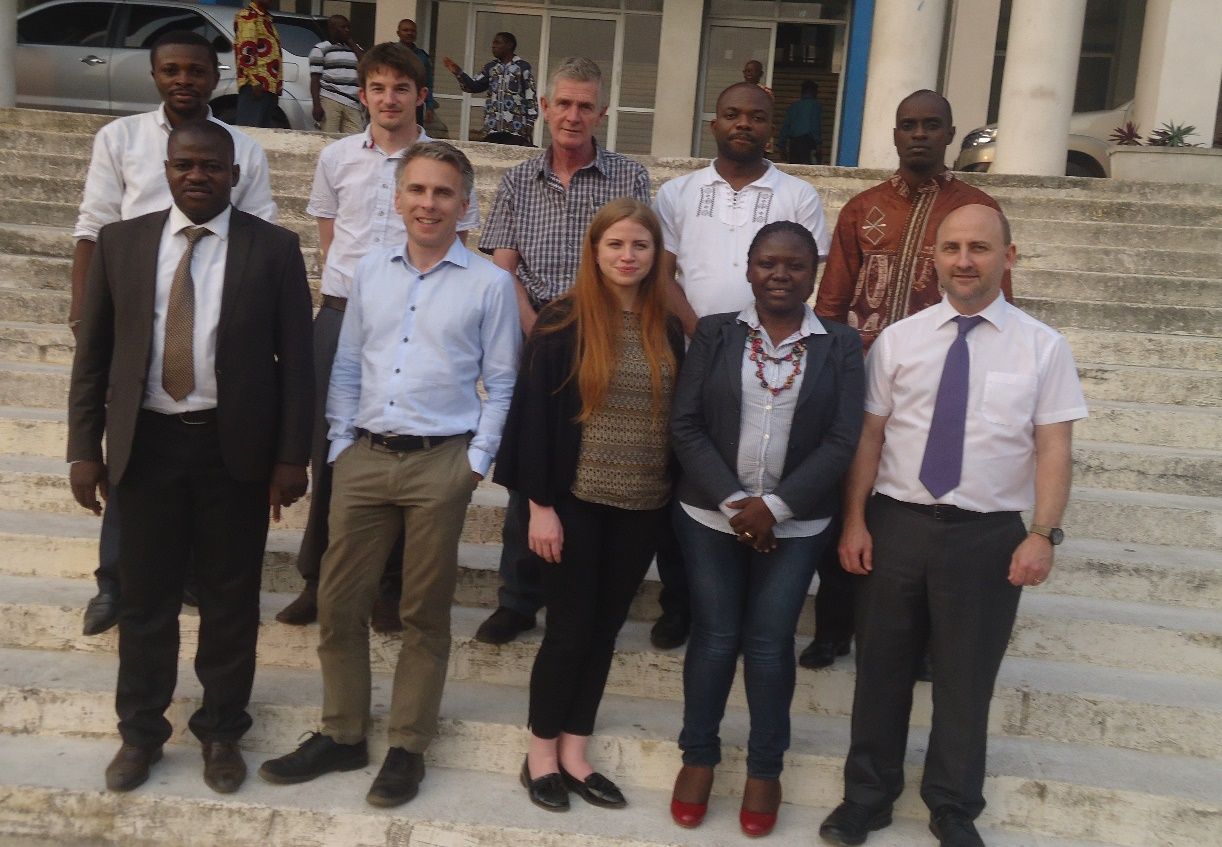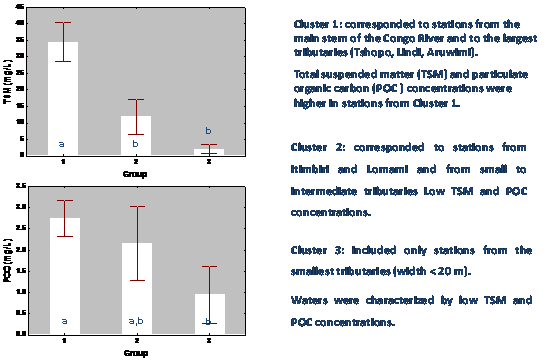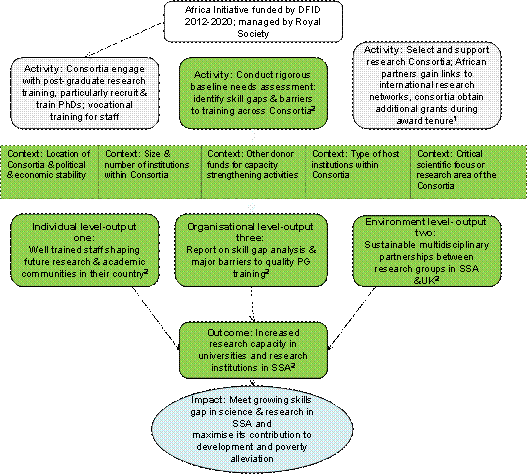One of the main activities identified for the implementation of the CRuHM project was the organization of an activity launch workshop. This workshop was therefore a unique opportunity for the consortium partners to meet among themselves and with other local experts, to harmonize the objectives of the project, compare different approaches with the realities on the ground, and to familiarize themselves with the local reality in the implementation of the project. The workshop was also an opportunity to share experience in this relatively new area of research in the Congo River Basin. Such experiences include the application cases of the Amazon, Orange, Zambezi and Pangani basins. Also applications of models such as Pitman, LISFLOOD, Weap, and SWAT models, etc..
This workshop was a crucial step in the implementation of the CRuHM project and focused on the following objectives
To gain a better understanding of the overall international, regional and local context of the project implementation and the expected project results;
To establish the current status of the basin’s baseline information and assess the information gaps with regards to the project objectives and results;
To evaluate the methodological framework including approaches, available resources and technology, plans and practicalities of longer field campaigns as well as supporting training programmes towards achieving the project results;
To explain the roles and expectations for members of the research programme group;
To discuss research plans and science questions to be addressed;
To meet end users and identify how science research can help to address some of their needs and acquire stakeholder inputs.
In the context of research capacity strengthening, DFID Capacity Building Facility is collaborating with Liverpool School of Tropical Medicine to assess the research capacity of the beneficiary institutions, and this constituted also an objective of the workshop.
The workshop targeted stakeholders, who are not necessarily in the education and research sector, but who work in the field of management and use of water resource in the Congo Basin. These included :
Members of the CRuHM consortium, namely the University of Kinshasa, the University of Dar es Salaam, Rhodes University, the University of Bristol, and the University of Leeds ;
Local and regional institutions involved in water resources management ;
Representatives of development projects ;
The Invitation was also open to other international researchers with an interest in improving knowledge of the hydrological processes of the Congo Basin.
Le tableau ci-dessous fournit des détails sur les institutions participantes :
| N° | Institution | Country | Numbre |
| 1 | University of Kinshasa | DRC | 11 |
| 2 | University of de Dar eS Salaam | Tanzania | 2 |
| 3 | University of Rhodes | South Africa | 2 |
| 4 | University of Bristol | United Kingdom | 2 |
| 5 | University of Leeds | United Kingdom | 1 |
| 6 | Liverpool School of Tropical Medecine | United Kingdom | 2 |
| 7 | UNESCO | DRC | 1 |
| 8 | PANAV | DRC | 2 |
| 9 | Ministère de Transport/RVF | DRC | 2 |
| 10 | Ministère de l'Environnement/DRE | DRC | 1 |
| 11 | Ministère de la Recherche | DRC | 1 |
| 12 | Ministère de l'Energie/SNEL | DRC | 1 |
| 13 | Ministère de l'Energie/REGIDESO | DRC | 1 |
| 14 | ERAIFT | DRC | 1 |
| 15 | CICOS | DRC | 1 |
| 16 | CRENK-K | DRC | 1 |
| 17 | WWF | DRC | 1 |
| 18 | Ambassade Britanique/DFID/Kinshasa | DRC | 1 |
| 19 | Banque Africaine de Développement | RDC | 1 |
| Total | 34 |
The approach to the workshop delivery with the stakeholders was mainly based on interactive presentations and participatory discussions led by resource persons. Facilitators included resource persons from the CRuHM consortium, National Hydrological Services, Development projects, and the River Basin Organisation.
Given that the workshop brought together multiple stakeholders and end users related to the water sector of the Congo River Basin, the central town was identified as the best location to host the workshop. The central town is located at approximately 30 km from the host institution, the University of Kinshasa. All foreign participants were also accommodated in the central town. A simultaneous translation was used to accommodate both English and French speaking participants.
The main activities during the inception workshop were:
Introductory visit to the host institution, the University of Kinshasa,
Meeting of consortium members,
Stakeholder meeting,
Research capacity development,
Field recognition.
Introductory visite to the host institution, the University of Kinshasa
The figure below shows members of the CRuHM consortium at the University of Kinshasa, where they received a welcome, and exchanged with the rector of the University of Kinshasa, the Deputy Rector in charge of academics, and the Deputy Dean of the Faculty of Agronomic Sciences, respectively.
Visit of the CRuHM consortium members at the host institution
Given that it was the first time for many of the members of the consortium to meet, a brainstorming meeting was therefore organised between them, where they were offered an opportunity to know each other better, harmonise views and gain a better understanding of the overall international, regional and local context of the project implementation and the expected project results.
Brainstorming session of the CRuHM consortium members at the host institution
The figure below shows participants at the stakeholder meeting that was held at the Cercle Alais in Kinshasa from 05 to 06 July 2016, and attended by 34 participants from 17 institutions, and four countries. Overall, the workshop encompassed four main sessions, namely:
Introduction to River Basin Organisation and hydrological services (International perspective);
Introduction to the Congo River Basin: current knowledge and Information gaps;
Capacity building and water resources development projects in the Congo Basin;
Group work.
The guest of honour for the workshop was the deputy rector in charge of administration, Prof. Miti, who expressed his acknowledgment for the efforts made in securing and implementing the CRuHM project necessary to address many challenges of water resources in the Congo basin and build capacities of the partner institutions. Prof. Miti took this opportunity to distribute to the participants a bunch of books from a symposium held in 2010 on water resources issues in the Congo basin, and was happy to say that the CRuHM is a result of recommendations made during the 2010 symposium. The books distributed identify a number of challenges and opportunities for sustainable management and development of water resources in the Congo River basin.
Participants at the stakeholders meeting
Introduction to River Basin organisation and hydrological Services (International perspective)
The session on River Basin Organisation and hydrological services (international perspective) aimed at providing global standards on river basin organisations and hydrological services so as to help establish a comparison status, draw gaps and identify needs for the Congo River Basin. In this regard, the situations of River Basin Organisation and hydrological services were presented for the United Kingdom (UK) and South Africa, where the following key notes were mentioned:
the development need for good hydrological services and effective monitoring of the water cycle to deal with challenges due to extreme hydrological conditions (UK);
Good coordination between the Environmental Agency and Met office (UK);
A well represented hydrological data collection network at the sub catchment level using mostly the Automatic Stations and sometimes the manual stations in UK;
Good information system on water that can be accessed online for a given site (SA);
Many stations have been closed due to limited human resources; more manual stations and some automatic stations well maintained at the sub-catchment level in SA;
Full involvement of UK government to support research that leads to sustainable.
Introduction to the Congo Basin: Current knowledge and information Gaps
Three presentations made in this session included:
Overview of the Congo Basin water resources potential
Hydrological services and monitoring in the Congo River Basin
Summary of past and recent research activities in the Congo River Basin
Overall the session highlighted key notes, including:
The river basin potentials: Second in the world after Amazon in terms of Discharge and drainage area; fifth longest river in the world; regular regime due to its geographical location (with equatorial line crossing the basin); proportion of contribution/sub-basin: C.central>Kasai>Lualaba>Oubangui>sangha>Bas-Congo; water uses: navigation, hydropower, Environment, Irrigation, fishery and drinking water.
The mandate of the national hydrological service (Régie des Voies Fluviales – RVF) to manage and maintain inland waterways, consisting of 25000 km.
The presentations made in this session also highlighted the main gap between the water availability and access to the available resources for socio-economic development, which is basically due to lack of technical resources and information to make effective use of the resources. The figure below illustrates the gap between the hydropower potential estimated at more the 100000 MW and the lack of access to energy in the basin.
Basically, the challenges of water resources management in the basin include a lack of necessary data at required spatial and temporal scales, lack of science based information to support decision making of water resources management, lack of technical capacities to make efficient use of the existing resources, land use and climate changes, and the lack of a consultation framework that encourages practical and innovative solutions to water resources problems. There has been a sensible decline in river gauges since the colonial period, which prevent adequate monitoring in the basin. Around 15 gauging stations are actually operational in the country, the oldest having a series of about 114 years of discharge data. Many of the historical data have been recorder and kept in paper archives, which need be digitized.
The lack of data has also prevented research outputs, especially when comparing with other major river basins of the world such as the Amazon. (A comparative situation in terms of water research outputs within Africa (GIZ, 2013), and between the Congo and Amazon basins (Alsdorf et al., 2016)).
The major consequence of this lack of information on the water resources dynamic of the basin is that there is little appreciation of the impacts of land use and climate changes in the basin.
Capacity Builiding and Water Resources Development Projects in the Congo River Basin
Several projects are carried out in the Congo basin with regard to water resources development, management and monitoring. This includes the project on Navigation (PANAV) funded by the European Union and hosted by the Ministry of Transport; the project on Transport sur les corridors multimodaux Pointe-Noire Brazzaville/ Kinshasa et Matadi-Kinshasa/Brazzaville-Bangui-Djamena, hosted by ECCAS; the project on Gestion Transfrontalière des Ressources en Eau du Bassin du Congo( GETRACO) funded by the German cooperation – GIZ and hosted by CICOS; and the project on sediment sampling in the Congo River Basin funded by the International Atomic Agency (IAA) and hosted by the CREN-K.
The objective of this session was therefore to identify progress made in terms of projects implementation with regards to data collection, water resources development objectives so as to identify areas of overlaps, possible collaborations and establish synergy.
The PANAV project was set up through the European Development Fund (EDF), to improve navigability of inland waterways in the Democratic Republic of Congo (DRC).
The financing agreement of 60 million euros was signed on December 1, 2010 between the DRC and the European Union and targeted three main waterways: Kinshasa – Kisangani on the Congo River, Kwamouth – Ilebo on the Kasai and Lake Tanganyika . The main objective of the project consists of four components which include: hydrography and hydrology, watercourse facilities and maintenance, port infrastructure and finally capacity building. Expected results include the establishment of an operational hydrographic study, river bathymetric maps and hydrological data to support the management and improvement of navigation on selected sections of the Congo River, with the possibility of developing a model 1D hydrodynamics; the establishment of a data processing center to support the RVF after the life of the project; create navigation albums using modern means (aerial images and GPS directions).
The project on transportation on multi-modal corridors such as Pointe Noire-Brazzaville/ Kinshasa and Matadi-Kinshasa/Brazzaville-Bangui-Djamena is a regional initiative to ensure connectivity between member states of the Economic Community Central African States (ECCAS). Under the navigation component of this regional initiative, some discharge and bathymetry measurements have been done at some tributaries of the Congo River (Brazaville-Kinshasa; Oubangui River at 605 Km from the capital city; Sangha at Ouesso) including Pool Malebo. The methodology involved cross sectional survey and discharge measurement at a spatial resolution of 50 Km, which provided 32 measurements in total using equipment such as Sonar, Total Station and ADCP.
The project on sediment sampling (the spatio-temporal variations of particulate materials in the Congo basin) in the Congo River Basin funded by the International Atomic Agency t(IAA) and hosted by the CREN-K is aimed an understanding the fluxes dynamics of dissolved and particulate matter and the carbon cycle in the Congo basin. It is implemented through a Consortium of the University of Kisangani, the Royal Belgian Institute of Natural Sciences of Belgium (Brussels), National Botanic Garden of Belgium (Meise) and the Royal Museum of Central Africa (Tervuren).
The figure below shows the sampling sites in Kisangani, Kivu, Oubangui, Kasai and Kinshasa that were used during the extensive sampling campaigns carried out through the project in 2010 with a monthly or two weekly frequency. The sampling campaign at Kasai,Kwango and Kwilu is based on an extensive data set of particulate organic carbon (POC), particulate organic phosphorous (POP), gazes (CO2, CH4, N2O), total suspended matter (TSM), Colored Dissolved organic Matter (CDOM), Isotopes (2H, 18O)*, Nutriments (NO3, NO2, NH4, SRP, P total) and dissolved organic carbon (DOC).
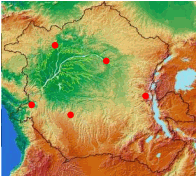
Sampling locations used for the project carried out in 2010
The presentation also provided a comparative overview of sediment sampling studies in the Congo basin. Few studies have addressed the consequences of land-use changes on aquatic environments in the Congo Basin. In contrast to numerous studies on the Amazon Rivers, little is known about the biogeochemistry of the Congo River. With this justification, a study was carried out and he presented the preliminary results. He noted much higher suspended sediment loads than most other studied sites in the Congo Basin (20-120 mg L-1) with a general increase in the annual debit etc. He ended his presentation by comparing the results of their study with those from earlier studies.
Some results obtained from the above mentioned studies were also presented (Figure 6), which include: Congo main stem (Kisangani – Bumba) and on its tributaries and sub-tributaries; Congo River at Kisangani; Kinshasa-Brazzaville site; Congo River Sub-basins; Kasaï River Basin. Preliminary data of Kasaï River gives 44.0 mg L-1 and 2.181 mg L-1 as the concentrations values of TSM and POC respectively. The distribution of organic carbon (OC) between POC and DOC fractions shows a domination of DOC for preliminary data as the percent of TOC derived from DOC equal to 70%.
Summary results of the studies carried out in the Congo basin on sediment loads.
Institutional Capacity and Research Experience of the CRuHM Partners (local, regional, international river basins experience)
The main tenet of this session was to help identify strength of the partner institutions in terms of research and capacity building delivery and how this could be used to contribute to the implementation of the CRuHM project in the Congo basin.
The session on Research Capacity Development was led by the Liverpool School of Tropical Medicine (LSTM) and consisted of an introductory presentation of the mission and activities carried out by the CRU in the framework of RS-DFID project implementation across Africa. The figure below gives a summary details of the mission and activities of the CRU. This introductory presentation was then followed by interactive discussions with the workshop participants; interviews with PIs, CRuHM PhD beneficiaries, Universities representatives; and ground assessment on the status of laboratories and equipment at the university of Kinshasa. The outcome report of this assessment will be shared with the stakeholders.
Summary of the missions and activities of the Research Capacity Unit.
The working group discussions were centred on the following three questions:
Stakeholders’ expectations in relation to the CRuHM project;
A framework for collaboration on aspects related to information and data exchange, training, use of equipment and field work;
Means to ensure complementarity and avoid duplication of any on-going projects in the basin.
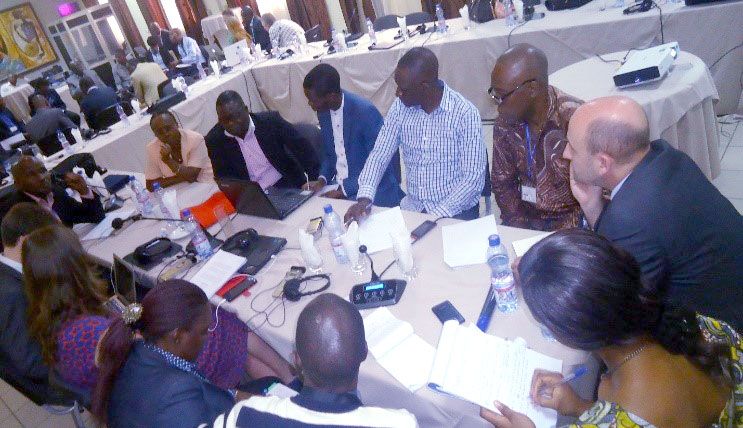
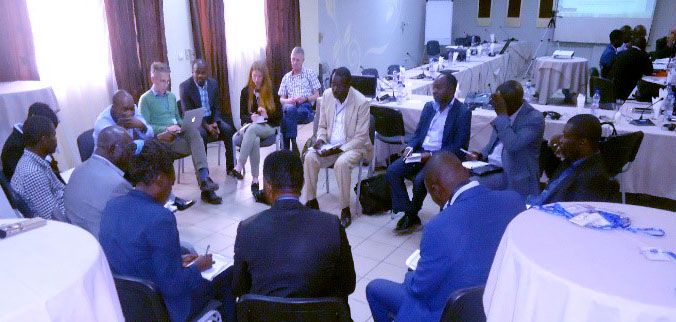
For researchers, the expectations were mainly related with access to data and cooperation with the available stakeholders, while for stakeholders, their main expectations were in relation to capacity building. Most stakeholders were very willing to cooperate in all aspects, and only insisted on signing memorandums of understanding.
On complementarity and duplication, there was caution about the quality of data. But also it was noted that science has several ways of doing things. And duplication could be a good thing such that one result could be used to validate the other.
Each member was given opportunity for final remarks and the workshop ended just before lunch.
Key notes from the discussion include:
The need to have a good management system of the hydrological data to avoid conflicts arising often from the overlapping of responsibilities of agencies in charge of hydrological and meteorological data collection and management in many African countries.
A well-established water resources monitoring system can help in the monitoring of the extreme hydrological events such as Flood and thus reducing damages.
Recognition of the economic value of the hydro meteorological data, to maintain the equipment, especially in countries where the government effort is not substantial.
There have been some challenges regarding the stability of some gauging sites that are used by RVF. This can be futher explored by researchers.
It has to be bear in mind that the Congo Basin water use for irrigation is not zero. Currently, there are some ongoing irrigation large scale projects.
To avoid overlapping of actions, there is a need for the Navigation Project to connect with other partners working on the same topic. For example, the Institut Géographique du Congo who are in charge of mapping of the landscape in DRC.
To ensure the sustainability of the outcomes from the Navigation Project, a capacity building programme is needed for the RVF to take over the continuity of actions. At this point, the connection with researchers will be useful so that the project can implement a Data Processing Centre that will generate information needed to support the Congo River users, such as navigation.
For the civil engineering applications, it is of great importance to consider the bed load while sampling the suspended sediment. Having a consistent database on this aspect will certainly contribute to the security of the hydraulic structures. Sampling techniques are set up based on the research objectives.
There is a need to establish a well-coordinated mechanism for sharing data among researchers in the Congo Basin. Since the government is not involved in the process (no funding for research), the workshops (scientific forums) remain the ideal framework for sharing data and information.
To get acquainted with the reality of field work in the Congo River, a field reconnaissance was organised in the mid reach of the Congo River between Kinshasa and Maluku (30 km).
Here the members of the CRuHM consortium during the field reconnaissance, which was facilitated by the Technical Department of RVF.
Members of the consortium during the field reconnaissance on the Congo River.
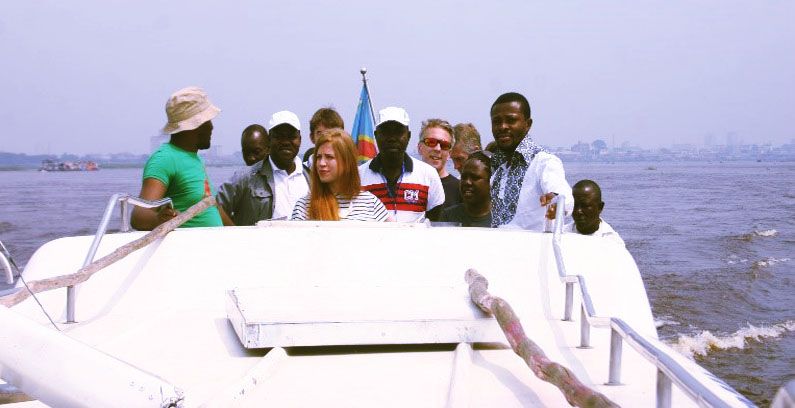
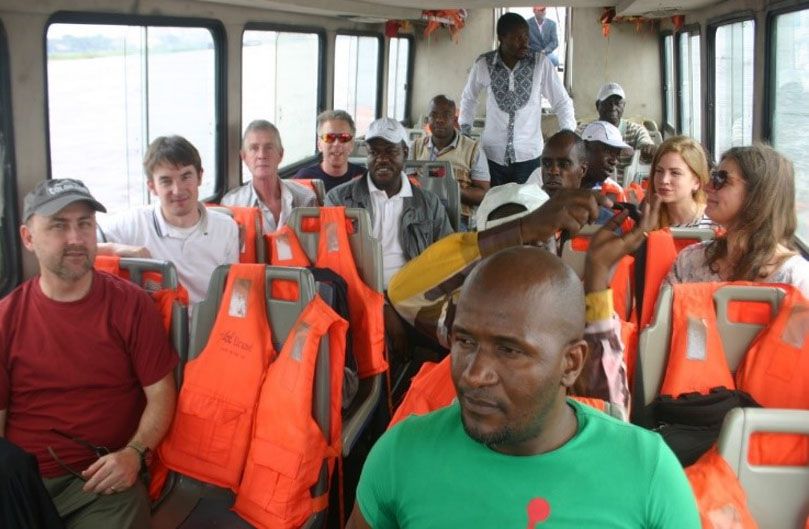
The inception workshop held in Kinshasa from 04th to 08th July 2016 involved several activities and constituted a major step for the implementation of the CRuHM project. The main activities carried out during the inception workshop consisted of stakeholders meetings, consortium meetings, and field reconnaissance. Overall, the inception workshop highlighted gaps, challenges and opportunities with regard to the objectives of CRuHM. The various presentations made during the plenary sessions provided an overview of concepts, approaches, necessary data and tools applicable in the field of focus for CRuHM. These presentations therefore enabled a comparative situation so as to identify gaps and challenges in the context of the CRuHM project implementation. Basic challenges include a critical lack of data, the complexity of water resources system, and the remoteness of the basin. The identified opportunities to overcome the foreseen challenges include planned field work activities which will help collect high quality data, very strong and internationally recognized expertise of the partner institutions in the field of CRuHM project implementation, availability of expert and modelling tools with technical capacity to update these tools to the new environment of the Congo basin, and collaboration with local experts and hydrological services.
